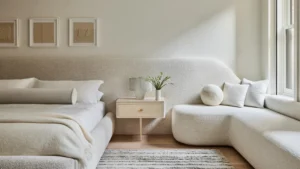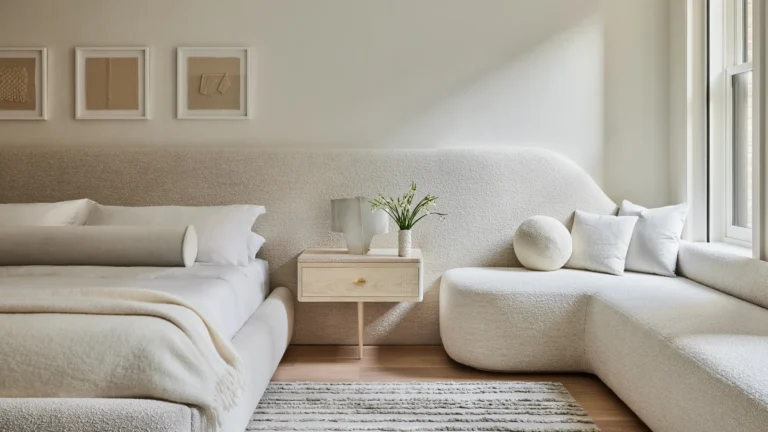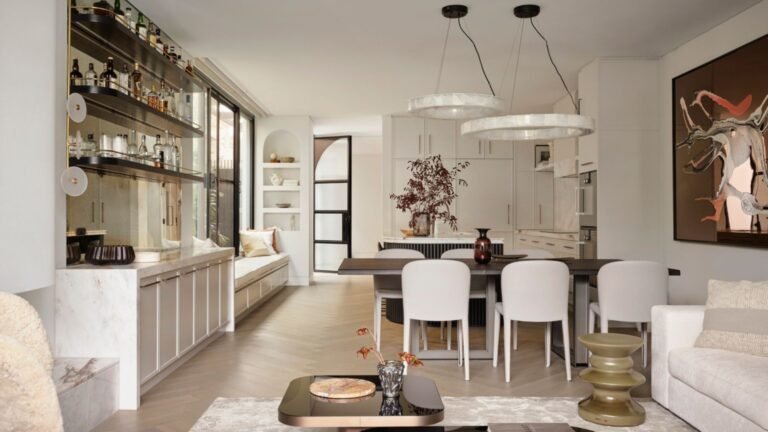1. Sustainable Luxury: Designing with the Planet in Mind
Sustainability is no longer a trend—it is a principle. In 2025, kitchen design sees a powerful shift toward eco-conscious elegance. This includes the use of:
- Reclaimed wood cabinetry for warmth and texture.
- Recycled glass countertops that shimmer with both beauty and conscience.
- VOC-free paints and finishes that ensure indoor air quality.
- Energy-efficient appliances with smart sensors and adaptive functions.
Designers are embracing natural materials with minimal environmental impact. Think bamboo shelving, cork flooring, and terracotta tiles—each telling a story of craft, tradition, and renewal.
Additionally, kitchens are being designed for longevity, not just looks. Custom, high-quality cabinetry and timeless materials help reduce the need for frequent remodeling, thus lowering waste and cost over time.
2. The Rise of the “Living Kitchen”
The 2025 kitchen is no longer an isolated workspace. Instead, it’s a seamless extension of the living and dining areas, both spatially and stylistically. This concept, often called the “living kitchen,” blends function with hospitality.
Key elements include:
- Open-concept layouts with large islands serving as the nucleus for cooking, working, and entertaining.
- Integrated storage systems that hide clutter behind sleek cabinetry.
- Furniture-style detailing on cabinetry and counters to mimic living room aesthetics.
Designers are also incorporating soft seating, curated artwork, and ambient lighting in kitchen spaces, creating zones where guests can relax as easily as the host can cook.
3. Statement Lighting: Sculptural and Smart
In 2025, lighting isn’t just functional—it’s a statement of identity.
Expect to see:
- Oversized pendants in organic shapes or hand-blown glass.
- Integrated LED strip lighting beneath countertops and shelves.
- Smart lighting systems that adjust brightness and color temperature depending on the time of day.
Layered lighting is key: ambient, task, and accent lighting are all thoughtfully blended to ensure both utility and mood. Fixtures are no longer hidden—they are curated, artistic pieces that express the homeowner’s personality.
4. Tech-Integrated Kitchens: Smart, But Seamless
Technology in the kitchen has matured. It’s no longer about flashy gadgets, but quiet intelligence that enhances the culinary experience.
Here’s what’s trending in 2025:
- Voice-activated faucets and smart ovens.
- Touchscreen refrigerators that track groceries and suggest recipes.
- Built-in wireless charging on countertops.
- Sensor-controlled lighting and ventilation systems for energy optimization.
Perhaps most notably, appliance design has become discreet. Ovens, dishwashers, and fridges are increasingly being panelled to blend into cabinetry, creating a clean and unified aesthetic.
The emphasis is on tech that adapts to human behavior—learning preferences, conserving resources, and providing a touchless, hygienic experience.
5. The Return of Color: Bold, Warm, and Botanical
While white kitchens will never go out of style, 2025 marks a vivid return to color—but not in chaotic ways.
Popular palettes include:
- Earthy greens (sage, forest, moss) that echo nature and serenity.
- Rich terracottas and clay tones, grounding the kitchen with warmth.
- Soft blues and dusty lavenders, offering a fresh but subtle charm.
- Matte black and charcoal accents, used sparingly to add drama.
Two-tone kitchens are also in vogue—think navy lower cabinets paired with creamy uppers, or natural wood mixed with painted finishes. These combinations bring depth and character to the space without overwhelming it.
6. Texture and Tactility: A Sensory Approach
Visual appeal is no longer enough. In 2025, designers focus on tactile richness, encouraging touch and interaction.
Look for:
- Ribbed wood cabinets and fluted glass panels.
- Matte stone countertops with honed or leathered finishes.
- Handmade tiles with imperfect, artisanal surfaces.
- Mixed metals—brushed brass, matte black, aged copper—offering a lived-in luxury.
Texture is applied with intention: not just for style, but to create moments of discovery throughout the kitchen.
7. Island Evolution: The Social Stage
Kitchen islands have always been functional, but in 2025, they are performance spaces. The island is where form and function converge.
Emerging island trends:
- Dual-level countertops to distinguish prep from gathering zones.
- Waterfall edges made from dramatic marbles or quartzites.
- Integrated wine coolers, cooktops, and charging stations.
- Seating for six or more, encouraging inclusive dining and interaction.
Some islands even feature pocket storage, hidden pop-up outlets, or extendable dining surfaces—maximizing usability in elegant ways.
8. The Pantry Renaissance
Walk-in pantries are getting a luxurious upgrade. Beyond storage, pantries are now prep spaces, coffee bars, and even secondary kitchens for large-scale entertaining.
Common elements include:
- Mini sinks, dishwashers, or microwaves for hidden clean-up.
- Custom cabinetry with open shelving and closed drawers.
- Pull-out spice racks, labeled jars, and integrated lighting.
The idea is simple: the pantry becomes a space that supports the performance of the main kitchen, keeping it clutter-free and camera-ready.
9. Biophilic Design: Bringing Nature In
In 2025, biophilic design—the integration of natural elements into built environments—takes center stage in kitchens.
This is expressed through:
- Indoor herb gardens and vertical plant walls.
- Skylights and large windows that flood the kitchen with natural light.
- Natural materials like wood, stone, and clay that connect us to the earth.
- Color palettes that reflect outdoor landscapes.
Biophilic kitchens are not only beautiful—they’re proven to enhance mood, reduce stress, and promote well-being.
10. Customization is King: A Kitchen That Reflects You
In 2025, the most important trend is individuality. Homeowners are moving away from cookie-cutter kitchens in favor of highly personalized spaces that reflect their lifestyle, heritage, and values.
Examples of this include:
- A built-in baking station for an avid home baker.
- A coffee bar inspired by European cafés.
- Cabinetry that hides pet feeding zones or child-friendly storage.
- Collections of handmade pottery, cookbooks, or vintage utensils displayed with pride.
The kitchen becomes an autobiography—a place where function meets meaning.
Conclusion: Designing the Heart of Tomorrow’s Home
As we look to the future, the kitchen remains a sacred space—not just for cooking, but for connection. In 2025, design is more than what we see. It’s what we feel, what we value, and how we live.
The kitchens of today are smarter, warmer, greener, and more beautiful than ever before. They honor craftsmanship while embracing innovation. They celebrate individuality without sacrificing elegance.
Above all, they serve as a mirror—reflecting who we are, and who we aspire to be.








